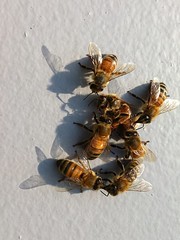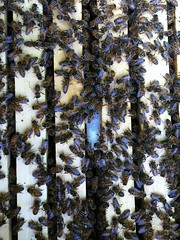 |
| better than a singing telegram |
Because so many of our milestones included queens, let's focus there. First off, we have a hive with a temperment that--we've slowly noticed--is terrible. Her name is Doris. When you smoke them, half fly off to attack the smoke (the "normal reaction"* is to retreat between the frames and gorge on honey). When you gently blow on them, entreating them to disperse so you can see the comb beneath, they bristle and buzz and half fly off to attack the wind
(the "normal reaction"* is to simply disperse). When they were a smaller hive, we'd noticed this spastic behavior, but it wasn't yet a problem. Their enlarged size seems to have emboldened them more (or maybe they just have a larger population of guard bees, whose job is to protect the hive). In any case, now that they are grown up (like the 6-hive-bodies-tall that they are right now), it takes longer to work them, which has proven a dangerous proposition. Even though they are doing a bang up job of bringing in the nectar (we just harvested 5 frames of light-colored honey from them), we can't afford to have bees that nasty, so we've decided to requeen (as the queen is the mother of every bee in the colony).
 |
| our new hive labels |
To this end, we ordered several queens from a genetic line that is known for its gentleness, acclimation to Northern climes, and its cleanliness (this can help in the management of pests and pathogens). That was the easy part. The hard part was just FINDING Doris's queen. When you must meticulously analyze each frame in a 6 body-tall hive (that's 60 frames) looking for one specific bee among tens of thousands of them, well, let's just say it takes a while. Over the past few weeks, we'd been through every frame at least twice and hadn't seen her.
 |
| attending their dead queen |
It was an inglorious way to end a dynasty--really, one that we resented but also really really respected (many say that aggressive bees can be the better honey collectors and survivors). We just didn't want to spend our lives with her. It seemed dangerous to us to have bees that pose a threat to people in the area. Even her drones would affect the genetics of other hives we'd keep out there. No, she had to go. Sorry, Doris.
We're not really sure how long it takes the bees to communicate to one another that they're queenless. We do know that when you take a queen from the hive, the nearby bees know it and may start fanning (releasing a certain phermone from their nasanov gland) to indicate to her where her hive is (see the video below for a shot of some bees in another hive doing this). After we killed Doris, we temporarily placed her on a board near the hive. Several bees attended her. We let them, thinking they could be the messengers. After a while, we moved the queen to the car and found that bees continued to linger in the spot where she'd lain.
We also know that a hive will not remain queenless for too long before they start the business of rearing a new queen. We've read accounts from varying beekeepers citing that this can happen within an hour, or could be as long as a day. Our experience last year was that a day was too long to wait before introducing a foreign queen. The bees were already committed to rearing their own and killed the queen we introduced. We didn't have an hour to wait with Doris, so we crossed our fingers and inserted the new queen almost immediately. Let's hope they like Quinn and decide to keep her. Though, to quote Winnie-the-Pooh, "you can never tell with bees." The video below shows the first reaction of Doris's bees to their new queen in her cage. We discuss this process a bit in an earlier post if you'd like some insight into what's actually happening here.
On a different note, we'll end on a treat that also involves queens. While working one of our favorite hives (and also our first) this weekend, we caught sight of the queen in the process of laying eggs (this was the first time we'd witnessed this process) and got a brief video. Enjoy.
*I will qualify "normal" as being normal to an Italian stock of bees that are the most popular in beekeeping due to their more docile personality. Of course one should not really refer to genetic traits of one type of bee as 'normal' and genetic traits of another type of bee as 'abnormal', but we're allowing ourselves some liberties.


No comments:
Post a Comment